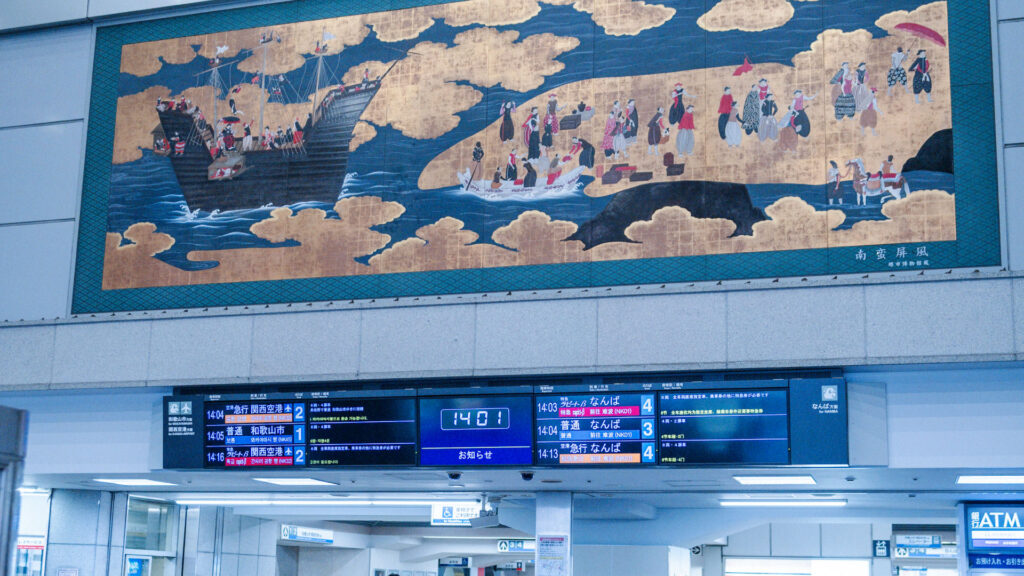
4 -Following the footsteps of the great tea master, Sen No Rikyu
2024.03.28
-
 ON THE TRIPAn audio guide app to enhance your travel experienceJust like an audio guide in a museum, ON THE TRIP provide on-the-spot audio guides at shrines, temples, spectacular views, and sightseeing spots in any travel destination. Download the app and your smartphone becomes your own personal travel guide!
ON THE TRIPAn audio guide app to enhance your travel experienceJust like an audio guide in a museum, ON THE TRIP provide on-the-spot audio guides at shrines, temples, spectacular views, and sightseeing spots in any travel destination. Download the app and your smartphone becomes your own personal travel guide!
Audio Time Travel is an article that allows you to enjoy a trip to Osaka while listening to a guide. You can enjoy a part of the audio guide in this article. The full audio can be experienced on the ON THE TRIP app.
INTRODUCTION
The port city of Sakai once saw “golden days” of enormous fame and influence. But where are the traces of that era? You may not sense them upon arriving at Nankai Sakai Station. It makes sense, given that the station area is on land reclaimed from the sea. The coastline, as well as the port, were originally located further inland.
On this trip, we will uncover the story of Sakai’s golden age: its unique luminaries and their sophisticated pastimes, which include the tea ceremony. We may also see the dark corners that were hidden from such glittering prosperity.
07| Sakai Plaza of Rikyū and Akiko

The “Sakai Plaza of Rikyū and Akiko” is located where the Sakai Shogunate is said to have existed. Here you can find the Sen-no-Rikyū Chanoyu Museum, where you can trace the tea master’s footsteps as you uncover the history and culture of Chanoyu tea ceremony.
Now we’ll introduce a story about Sen-no-Rikyū. He had a friend named Hechikan, who was also a disciple of Rikyū’s master. One day, Rikyū was invited to tea, and when he made for Hechikan’s home, he found traces of what looked like a pitfall dug into the ground. Moreover, smoke seemed to be rising from the direction of the bath.
Rikyū caught on to Hechikan’s intent and, feigning ignorance, dropped into the pit. Hechikan looked as innocent as a dove when he said, “Bath’s ready.”
Hechikan said with his actions that the tea drunk after a good bath is the tastiest, and Rikyū followed his logic. This comical, mutual contest of wits embodies the kind of sophisticated games the Chanoyu tea masters of Sakai encouraged and nurtured.
08| Ruins of Sen-no-Rikyū’s Mansion

The ruins of Sen-no-Rikyū’s mansion sit opposite the Sakai Plaza of Rikyū and Akiko. The roof over the well here uses wood from the main temple gate of Daitokuji Temple in Kyoto, which is inseparable from Sen-no-Rikyū himself.
Rikyū taught the way of the tea ceremony to Daimyo Toyotomi Hideyoshi. The pair were close, with Hideyoshi coming to him not only for matters of tea but also for political counsel. However, when Rikyū angered Hideyoshi, he committed suicide via seppuku. What could’ve happened between them?
Many theories attempt to explain the reason. One such reason concerns Daitokuji Temple’s main gate. Rikyū invested money in repairing the gate, and to show his gratitude, the chief priest carved and enshrined a wooden statue of Rikyū at the top of the gate. This made Hideyoshi furious, exclaiming to Rikyū, “Every time I pass through this gate is akin to being trampled under your feet.”
Moreover, he was accused of corruption by mass-producing tea utensils without permission. Owning tea utensils, which were expensive due to their scarcity, was an honor for the samurai class. Despite that, Rikyū had a personal craftsman create original tea utensils. Hideyoshi feared that if Japan’s top tea ceremony master entered the manufacturing game, his own collection would depreciate and lose its value as a reward for the samurai class.
He had his reasons, but Hideyoshi ordered the one and only Sen-no-Rikyū to open his own belly in ritual suicide. Thus died a Chanoyu luminary, one who greatly influenced the powers that be. We invite you to take a moment and imagine what sort of person Sen-no-Rikyū was.
09 | Sakai Keshi-mochi

Near the Sakai Plaza of Rikyū and Akiko you will find a confectionary store that sells “Keshi-mochi.” Let’s take a breather here and have a bite of something sweet. “Keshi-mochi” uses “keshi,” or poppy seeds, and these were first brought to Japan on Nanban ships. It’s said Sen-no-Rikyū loved keshi-mochi, which led to its popularity in the tea ceremony.
By the way, poppy seeds contain a small amount of opium and were imported in Nanban ships as ingredients for morphine and other sedatives. It’s only a trace amount, so they’re perfectly safe to eat, of course. Their crunchy texture combined with the softness of the mochi makes for a truly delectable treat.
But why were poppy seeds in demand? The reason is deeply rooted in the Warring States Period. Poppy was used as a sedative for treating wounded soldiers and to relax combat-high warriors who had spent the day killing people. As a matter of fact, the caffeine found in tea was indispensable when storming castles. It was a convenient stimulant during nocturnal assaults and was also useful in heightening morale.
But it became a luxury item after the wars abated, and it’s still enjoyed to this day. Gunpowder used in firearms was repurposed for fireworks, and poisonous chemicals became pesticides and other agrochemicals. New industries were born from the fires of war. Swordsmiths in Sakai turned to knifemaking to support Osakan gastronomy. This marked the end of Sakai’s “golden days,” but that is a story for another time.
*This guide was created based on documents and interviews and includes some interpretation done by us at ON THE TRIP. Theories differ between experts, so try to find out what really happened on your travels!
*Information presented here is current as of 2024. Please check the websites of the individual shops and facilities for up-to-date information on business hours.














